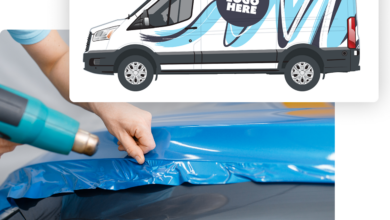Ever since I started to learn about wraps over 20 years ago, I have been told how important it was to post-heat. I have heard different explanations. The two most common were “breaking the memory” or “resetting the memory” of the film.
The simple step of post-heating prevents the film from lifting up and failing after installation. It also serves as an opportunity for a close-up quality check of your wrap. As you go over areas that require the post-heat you can look for areas that may have been missed or areas where the air is accumulating to form bubbles.
What areas need post-heating?
A good rule of thumb is to post-heat any area where the film has been stretched more than 10%. This is especially important on recessed areas where the film is prone to lifting. These areas include, but are not limited to, door handle cups, window channels on vans, channels around wheel wells, bumpers, as well as along panel edges where the film was stretched such as mirrors.
What is the post-heat temperature?
The recommended post-heating temperature is typically anywhere between 175 F to 195 F. It is important to use an IR thermometer to double-check your post-heating temperature. You will find that 175-195 F is a lot hotter than you realize and using an IR thermometer ensures you hit the proper temperature. The IR thermometer doesn’t need to be an expensive unit. The one I use regularly is just a $20 device from Harbor Freight. In addition to the low cost, it is relatively compact, so it is easy to put in my tool belt to keep it handy.
Heat gun vs. torch for vehicle wraps
It has been my experience that the torch does not work well for post-heating. The torch produces a very intense and focused heat that tends to burn the film before it reaches the post-heat temperature. The heat from a heat gun puts out a wider cone of heat and heats a larger area.
The process of post-heating
There are a few different options for post-heating. Note that all methods use an IR thermometer, however, higher-end heat guns have the IR thermometer built-in instead of using a separate device.
You simply point the IR at the area to be post-heated while keeping the heat gun moving slightly so the film isn’t burned. Once you reach a minimum temperature of 175 F, move along the vehicle. This process does not add a lot of time to your installation, and it helps ensure the vehicle will not come back for vinyl lifting.
Post-heating without hitting minimum temperature
If you choose not to post-heat or don’t double-check your temperatures to ensure you are achieving the minimum post-heat temperature, there is a good chance the film may lift. This is especially true in areas where there is a lot of tension in the film. For example, an improperly post-heated piece of film can shrink back to its original form while a properly post-heated piece keeps its shape.
I typically recommend installing the entire side of a vehicle or at least several panels then go back and post-heat. This gives the adhesive time to build on the panel, and if there is any air trapped under the panel, it accumulates into pockets that can be pressed out as you work.
It is also recommended to do a final inspection the day after your wrap before releasing it to your customer. This gives you the opportunity to do one last inspection.




